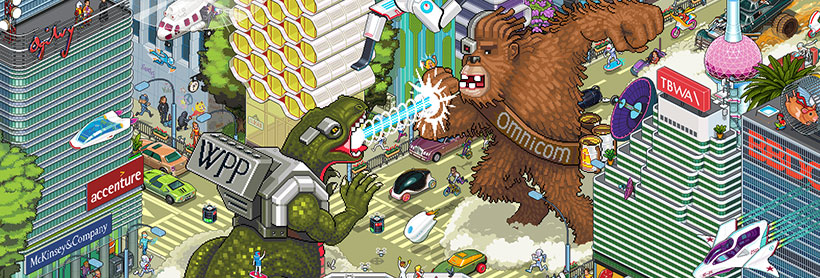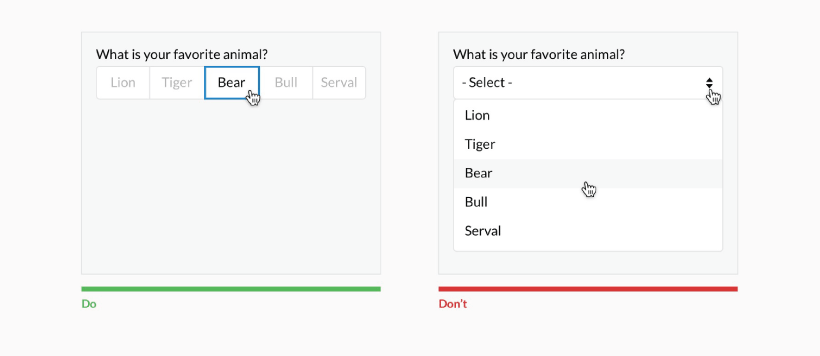- |
- |

Well, 2016 has certainly been interesting. From the Doggies winning the AFL Grand Final to ‘The Donald’ winning the US election, the year’s been a surprisingly mixed bag of highlights, underdogs, flare-ups, let downs, and everything in between.
However you feel about it, 2016 has been packed to the brim with all kinds of epic events.
It’s been similarly eclectic as far as our office reading habits are concerned. In 2016, we’ve read about Tupac’s techniques for improved writing. We’ve learned the ‘subtle art’ of not giving a f***. We’ve looked into how Steph Curry sees the world. And all in addition to hundreds of pieces on UX, content, design, and technology. To cap the year off, I’ve hand-picked my favourite eight pieces from the past year. Enjoy!
1. The dotted line principle: start today, fill in the gaps tomorrow.

- Read the full article here.
- Written by: Herbert Lui.
- Contributor: Elliott Grigg.
I’m a copywriter, which naturally means I’ve always loved hip-hop. I spent a large portion of my teenage years poring over lyrics, remembering rhymes, and generally salivating over wordplay. Hip-hop is full of valuable lessons – how and when to ‘Drop It Like It’s Hot’ for example – but I never thought I’d turn to a rapper for writing tips, or any kind of professional guidance.
Enter Tupac Shakur and the ‘dotted line principle’. Inspired by the rapper’s prolific creative process, it’s a methodology for loosening up as a writer and getting your thoughts on the page. Being productive, rather than a perfectionist. If you’ve ever been paralysed by the thought of staring at a blank page for hours on end, this one’s for you.
Thanks, Tupac.
2. The art of service: secrets of the maître d’.

- Read the full article here.
- Written by: Jay Rayner & Tim Lewis.
- Contributor: Sarah El-Atm.
‘If you get the hospitality right, the food tastes better’, according to Fred Siriex. As one of London’s most famous maître d’s, Fred knows his craft, and his consultative wisdom applies far beyond the realm of cuisine. Great hospitality, like so many businesses and experiences, hinges on establishing and maintaining connection with an audience.
Whatever the nature of your work – whether in a digital agency or a dining room – good service is about understanding people, providing comfortable experiences, and being transparent. But that’s just the start. Check out Fred’s other secrets and up your service game.
3. Not every comparison needs to be toxic.

- Read the full article here.
- Written by: Gregory Ciotti.
- Contributor: Mike McCusker.
Whether you work in a creative environment or not, it’s tempting to compare yourself to others. More accurately, it’s tempting to compare yourself to awesome: it’s easy to seek out high calibre, high profile work and use that as the standard. In this piece, Gregory Ciotti offers some valuable insight – the best of the best isn’t a great benchmark.
You need to know the good, the bad, and the ugly, and you need to expose yourself to all of them regularly. Comparison can be damaging, or it an empowering source of learning. The choice is yours.
4. State of the Digital Nation 2016.

- Read the full article here.
- Written by: Jules Ehrhardt.
- Contributor: Daniel Banik.
Prepare to tumble down the rabbit hole. This is an epic wrap-up of trends, opportunities, ideas and observations pertaining to the past three years of the broad stroke industry we call ‘digital’. The digital world tends to evolve at a rapid pace, so you can imagine the potential scope of a three-year retrospective interrogating the past, outlining the present, and predicting the future. If you don’t have any plans for the next three years, treat yourself and have a read.
All jokes aside, State of the Digital Nation 2016 is an exceptionally detailed, insightful, frank, and wryly hilarious analysis of the industry. There’s something for everyone and myriad nuggets of wisdom. Jules Ehrhardt is also eminently quotable: ‘with great irony, like turkeys selling Thanksgiving, the advertising industry is excitedly pushing the very robots that will ultimately replace them (programmatic anyone?)’. This is straight-up knowledge, no bullshit.
5. Illustrations are more than digital eye candy.

- Read the full article here.
- Written by: Stephen Murrill.
- Contributor: Sylvia Pho.
The old saying suggests ‘a picture tells a thousand words’. Thankfully for me — a purveyor of the written word — Stephen Murrill is quick to point out that: ‘The Old Man and the Sea doesn’t contain any sweet graphics. Good writing stands tall without ornament’. While I take some solace in this sentiment, most people aren’t scanning blogs, feeds or websites for Hemingway. The reality is that imagery is an essential aspect of online content.
In fact, good illustration can actually improve written content. A great visual style can also help establish a brand personality, create a deeper connection with your audience, and articulate ideas more impactfully and accessibly. When you think about it, a point well illustrated really is a point well illustrated.
6. Design better forms.

- Read the full article here.
- Written by: Andrew Coyle.
- Contributor: John Broadfoot.
Whether it’s a newsletter sign-up process, a donation portal, or a data entry interface, poor form design is just… poor form. Given they’re one of the most prominent and important aspects of digital product design, it’s worth knowing your stuff when it comes to forms. No-one wants to spend time carefully cataloguing and submitting their details, but a good form can be streamlined and inoffensive.
This piece is absolutely jam-packed with practical insights and best-practice design. It also comes in at a total word count of 171 (excluding image captions and subheadings). Sometimes, writing is the wrong approach – I’m a huge fan of using the right tools to tell a story most effectively. With a keen focus on imagery and an easy-to-follow ‘do’ and ‘don’t’ format, this article deliver perfectly upon its simple promise: design better forms.
7. Context is king.

- Read the full article here.
- Written by: Daniel Marks.
- Contributor: J.D. Santiago.
We’ve all heard ‘content is king’. Bill Gates wrote those immortal words in 1996, and while they still ring true today, context is becoming just as important. There’s no use indiscriminately blasting content at people, regardless of the quality. Our environment plays an essential role in how we respond to messaging.
Shouting might seem more powerful than whispering. Until you’re in a library. Then shouting seems unhinged.
From a marketing perspective, location, behaviour, audience, time, situation, intent, and platform all have a role to play in determining the impact of your content. And while they may seem like limitations, there’s actually an enormous amount of untapped potential creativity to be mined from these perceived constraints. If knowing your audience is an essential factor in engaging them, context brings the x-factor for your messaging.
8. The psychology of persuasion.

- Read the full article here.
- Written by: Jory MacKay.
- Contributor: Elliott Grigg.
‘Art is a lie that tells the truth’ said Picasso. Ursula Le Guin suggested ‘a novelist’s business is lying’. ’If you can lie, you can act’, at least, according to Marlon Brando. Beyond some of the world’s greatest artists, con artists, politicians and salespeople love to make us believe: to convince us of the validity of an idea, a method, a deal, or a product. As author and artist Hugh MacLeod puts it:
‘The market for something to believe in is infinite.’
Engaging storytellers, good writers, and successful marketers are all the same too. They’re all united by a shared ability to manipulate ‘truth’ to achieve a desired outcome. So what do you do when the majority of the world’s professions are designed to artfully pull the wool over your eyes? Learn their techniques. If you can’t beat ‘em, join ‘em.
***
And that’s it for a year’s worth of articles that motivated, innovated, and inspired our team We’ll be back with more excellent reads in 2017, so stay tuned for the next edition from your ever-reliable August cur-8-tors. Until then, enjoy the holidays!
More Articles
Up for some more?
Get your monthly fix of August happenings and our curated Super8 delivered straight to your inbox.
Thanks for signing up.
Stay tuned, the next one isn't far away.
Return to the blog.
